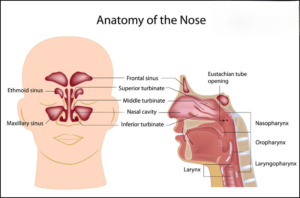 Your nose anatomy includes:
Your nose anatomy includes:
Bone: The hard bridge at the top of your nose is made of bone.
Hair and cilia: Hair and cilia (tiny, hairlike structures) inside your nose trap dirt and particles. Then they move those particles toward your nostrils, where they can be sneezed out or wiped away.
Lateral walls (outer walls): The outer walls of your nose are made of cartilage and covered in skin. The walls form your nasal cavities and your nostrils.
Nasal cavities: Your nose has two nasal cavities, hollow spaces where air flows in and out. They are lined with mucous membranes.
Nerve cells: These cells communicate with your brain to provide a sense of smell.
Nostrils (nares): These are the openings to the nasal cavities that are on the face.
Septum: The septum is made of bone and firm cartilage. It runs down the center of your nose and separates the two nasal cavities.
Sinuses: You have four pairs of sinuses. These air-filled pockets are connected to your nasal cavities. They produce the mucus that keeps your nose moist.
Turbinates (conchae): There are three pairs of turbinates located along the sides of both nasal cavities. These folds inside your nose help warm and moisten air after you breathe it in and help with nasal drainage.
What conditions and disorders can affect your nose?
Health conditions that can affect your nose include:
Allergic rhinitis: Allergic rhinitis (hay fever) can cause irritation, sneezing, runny nose or stuffy nose.
Deviated septum: A deviated septum occurs when your septum is off- center, either at birth or from injury. It can cause breathing problems, nasal congestion and headaches.
Enlarged turbinates: Allergens and irritants can make the turbinates swell, which can block airflow and affect normal breathing.
Injury or trauma: Your nose can be broken or injured, similar to any other external part of your body.
Infection: An infection can cause many of the same symptoms as allergic rhinitis. Examples include sinus infections and the common cold.
Nasopharyngeal cancer: Your nose can be the site of head and neck cancer.
Nasal polyps: Nasal polyps are bumps that can block airflow or prevent your nose from filtering air.
Nasal valve collapse: Often caused by an accident or trauma to your nose, nasal valve collapse is the most common cause of nasal obstruction.
Nosebleed (epistaxis): Nosebleeds occur when a blood vessel in your nose breaks. They are common, and most aren’t serious.
